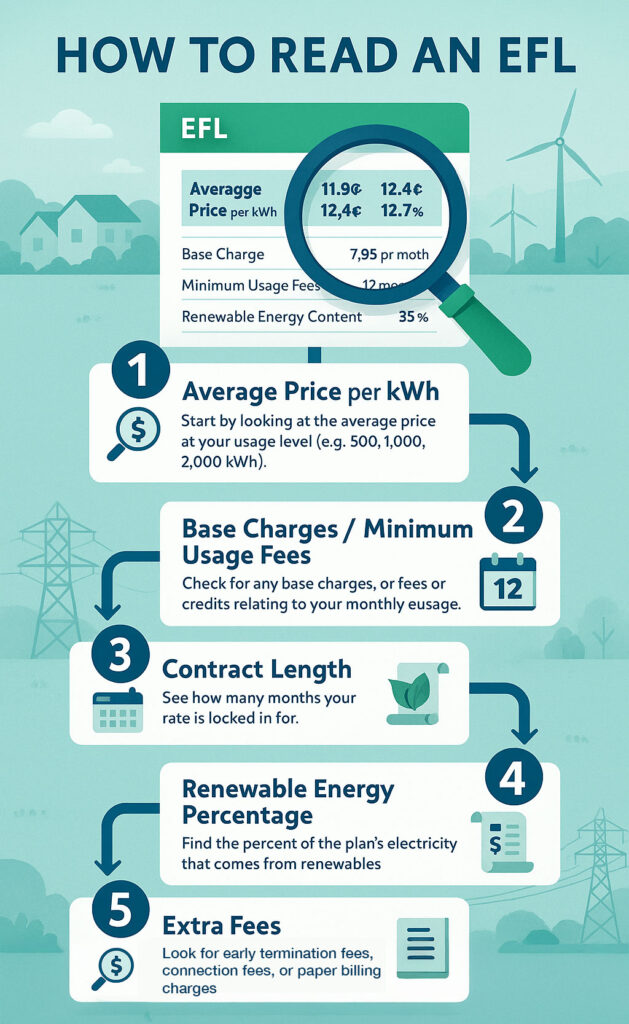Key Takeaways
- Always check the estimated cost at your usage level (500, 1,000, or 2,000 kWh) to see the true rate you’ll likely pay.
- Know how long your rate is locked in and whether it’s fixed or variable to avoid surprise price hikes.
- Look for base charges, minimum usage fees, and early termination fees that can add unexpected costs.
- See how much of the plan’s electricity comes from green sources if sustainability matters to you.
When you’re shopping for a new electricity plan, it can feel like every provider is speaking a different language. That’s where the Electricity Facts Label (EFL) comes in. Think of it as the “nutrition label” for your electricity plan, it breaks down exactly what you’re getting and what it will cost. Let’s walk through it together so you can feel confident in your choice.
What is an EFL?
An Electricity Facts Label is a standardized document that electricity providers are required to give you. It’s designed to help you compare plans side by side. Just like a food label shows calories, sugar, and fat, an EFL shows the important details of your plan, like pricing, fees, contract length, and renewable energy content.
The goal is transparency. Instead of flashy marketing promises, you get the raw facts in black and white.
Why an EFL is Important
You wouldn’t buy a car without knowing the gas mileage, right? Choosing an electricity plan is the same way. The EFL helps you:
- Avoid surprises. Understand all fees and conditions before you commit.
- Compare apples to apples. Since all providers must follow the same format, you can line up two EFLs and clearly see which plan fits your usage.
- Protect yourself. Know the rules around rate changes, contract lengths, and cancellation penalties.
In short, the EFL helps you make a smart, informed decision instead of relying on fine print or sales pitches.
How to Read an EFL

At first glance, an EFL can look intimidating, but once you know the sections, it’s straightforward. Here’s a step-by-step approach:
- Start with the average price per kWh. This is usually broken down into sample usage levels (like 500, 1,000, and 2,000 kWh).
- Check the base charges or minimum usage fees. Some plans look cheap but add extra costs if you don’t hit a certain usage level.
- Look at the contract length. Shorter contracts give you flexibility, longer ones often lock in lower rates.
- Find the renewable energy percentage. Want a greener plan? This number shows how much of your electricity comes from renewable sources.
- Scan for extra fees. Things like early termination fees, transmission charges, or minimum usage penalties are always listed here.
Key Items on an EFL
Here are the most important sections you’ll see on nearly every EFL:
- Average Price per kWh: Usually shown at 500, 1,000, and 2,000 kWh. Pay attention to the range that matches your household’s monthly usage.
- Base Charge / Minimum Usage Fee: Some plans add a fee if your usage is too low, or give you a credit if you use more.
- Contract Length: The number of months your rate is locked in.
- Early Termination Fee (ETF): What you’ll pay if you cancel before your contract ends.
- Type of Rate: Fixed, variable, or indexed. This determines if your price can change during the contract.
- Renewable Energy Content: The percentage of the plan sourced from wind, solar, or other renewables.
- Other Fees: Such as late fees, paper bill charges, or connection fees.
How to Estimate Your Electric Bill
An EFL doesn’t give you your exact monthly bill, but you can use it to make a good estimate:
- Find your monthly usage: Check past bills, or use an average (about 1,000 kWh for a typical Texas home).
- Match it to the EFL’s usage chart: See what the provider estimates for that level of usage.
- Add base charges and fees: Don’t forget minimum usage fees, customer charges, or extras like paper billing.
- Factor in taxes and TDU delivery charges: These are set by your local utility and apply no matter which provider you choose.
Example: If you use 1,200 kWh a month, and the EFL shows an average of 12¢/kWh at 1,000 kWh, your estimated supply charge would be about $144 (1,200 × $0.12). Then add in base fees and TDU charges for a realistic bill.
The Electricity Facts Label may look dry, but it’s your best friend when choosing an electricity plan. By focusing on the average price, fees, contract terms, and renewable content, you’ll quickly spot whether a plan truly fits your household’s needs.
Take a few minutes to compare EFLs before signing a contract, you’ll thank yourself when your bills arrive and there are no surprises.
FAQs about Electricity Facts Labels
What exactly is an Electricity Facts Label (EFL)?
Why is the “Price per kWh” on my bill different from the average rate shown on the EFL?
Pass-through TDU Charges: The EFL lists these charges separately, but your bill combines them with your energy charge.
Your Exact Usage: If you use more or less electricity than the example level, your average rate will change because fixed monthly charges are spread across different amounts of usage.
The EFL shows that a plan is “100% renewable.” What does that mean?
Where can I find the EFL for a plan I’m considering?
– On the provider’s website, directly on the page for the specific plan.
– On your state’s official electricity shopping website (e.g., PowerToChoose.org in Texas).
– Provided by a sales representative upon request before you enroll.
Is the EFL the final and complete document for the terms of my agreement?
About the Author
LaLeesha has a Masters degree in English and enjoys writing whenever she has the chance. She is passionate about gardening, reducing her carbon footprint, and protecting the environment.
